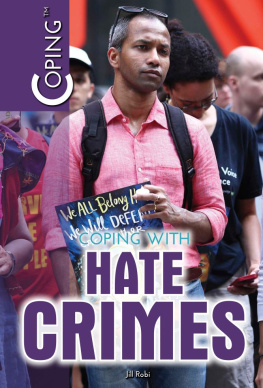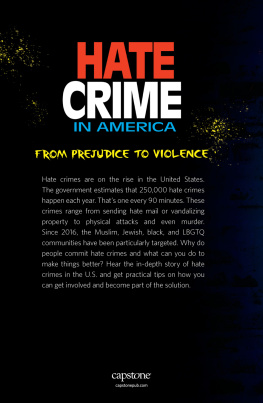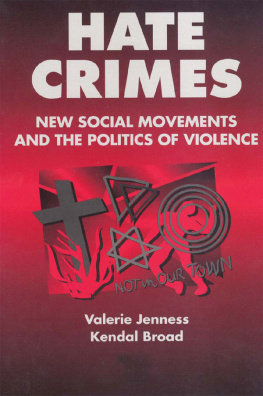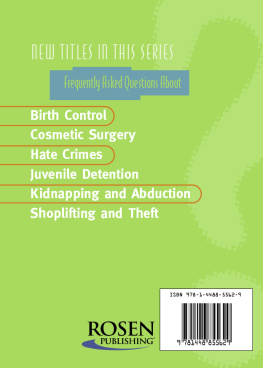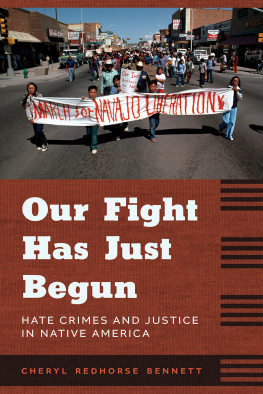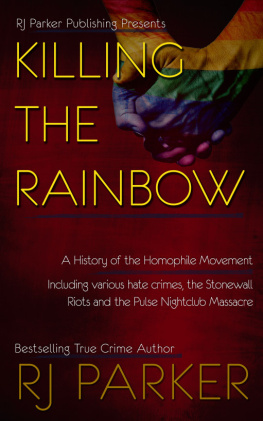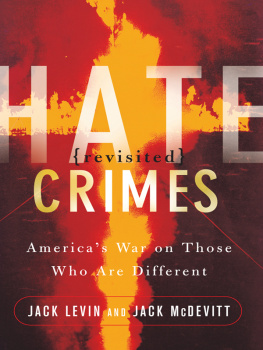Published in 2019 by The Rosen Publishing Group, Inc.
29 East 21st Street, New York, NY 10010
Copyright 2019 by The Rosen Publishing Group, Inc.
First Edition
All rights reserved. No part of this book may be reproduced in any form without permission in writing from the publisher, except by a reviewer.
Library of Congress Cataloging-in-Publication Data
Names: Robi, Jill, author.
Title: Coping with hate crimes / Jill Robi.
Description: New York : Rosen Publishing, 2019 | Series: Coping | Audience: Grades 7-12. | Includes bibliographical references and index.
Identifiers: LCCN 2018017291| ISBN 9781508183228 (library bound) | ISBN 9781508183211 (pbk.)
Subjects: LCSH: Hate crimesJuvenile literature.
Classification: LCC HV6773.5 .R63 2019 | DDC 364.15dc23 LC record available at https://lccn.loc.gov/2018017291
Manufactured in the United States of America
CHAPTER ONE
Identifying a Hate Crime
CHAPTER TWO
Causes and Effects of Hate Crimes
CHAPTER THREE
Hate Groups in the United States
CHAPTER FOUR
Responding to Hate Crimes
CHAPTER FIVE
Changing the Culture of Hate
I n the early hours of the morning of December 10, 2017, Jason and Victoria Chapa were on their way home from a family gathering. They decided to make a quick stop to look at a property in a developing area of their hometown of Marion, Texas, which they were considering purchasing. As they walked around the house, they heard the sound of glass shattering and ran back to their vehicle. What they found was shocking.
A woman named Melissa Shelton was using a shard of concrete to smash in the back windshield of their car while screaming racial slurs at the couple and saying they were too poor to move into her neighborhood. Jason Chapa is Mexican American, Victoria Chapa is African American, and Melissa Shelton is white.
When the Chapas called 911, police officers arrived at the scene but they did not issue Shelton a citation or take any action. The neighborhood housing association, the local realtors, all offered nothing but a silent endorsement of the attack," said attorney S. Lee Merritt, who represented the Chapas. This was not Black History Month. This is not black history. This didnt happen 50 years ago. It happened a few weeks ago. This is America 2018" After public outcry, the Marion Police Department handed over the police report to the District Attorneys office, and Shelton was eventually indicted.

According to the Federal Bureau of Investigations (FBI) annual Hate Crimes Statistics report, there were 6,121 hate crimes reported in 2016. This is an average of more than sixteen hate crimes a day, and it represents a 5 percent increase from 2015 and a 10 percent increase from 2014. A hate crime is a term used for a crime that is committed against someone due to an aspect of the victims identity, such as race or ethnicity, religious beliefs, sexual orientation, disability, or gender identity. Hate crimes can include acts of violence or assault, name calling (both in person or online), and vandalism to property.
A hate crime goes beyond the act of violence itself; it affects an entire community. A hate crime is not an isolated incident, but part of a system in which marginalized groups of people fear for their safety merely because of who they are. People who have been the victims of hate crimes, or whose communities are regularly impacted by hate crimes, often suffer from PTSD or experience ongoing fear and trauma.
Addressing hate crimes begins with understanding the root of the problem and working to change the culture of hate, bigotry, and prejudice that thrives in communities across the United States. By examining the history of hate crimes in America, it is possible to gain a better understanding of the current situation.
There are a number of resources across the country that provide support for victims of hate crimes and their communities. There are also organizations and advocates working to change the culture of hate. Often this type of work begins with people organizing locally to raise awareness of prejudice in their own schools, workplaces, and communities. By learning about the history, scale, and impacts of hate crimes in the United States, you can learn to be part of the solution and work toward changing the culture of hate.
T he Merriam-Webster dictionary defines hate crimes as any of various crimes (such as assault or defacement of property) when motivated by hostility to the victim as a member of a group (such as one based on color, creed, gender, or sexual orientation). Hate crimes cover a broad spectrum of incidents, including physical assault, homicide, mass shootings, sexual assault, rape, vandalism, symbolic acts, verbal abuse, and online harassment.
Hate crimes are caused by prejudice against specific groups of people based on inherent aspects of their identities, such as race, religion, sexual orientation, gender, gender identity, and disability. The FBI notes that Hate itself is not a crimeand the FBI is mindful of protecting freedom of speech and other civil liberties. However, when a person commits a crime that is motivated by hate, that is a hate crime.
Types of Hate Crimes
A hate crime can occur anywherein the workplace, at school, in a park, on public transit, on social media, in an email, in printed materials, or elsewhere. A good number of hate crimes go unreported to police, especially if they are nonviolent. Often, the victim may not even be aware that a hate crime has occurred.
Verbal Abuse and Online Harassment
Verbal abuse and online harassment count as crimes when they include a threat that the victim has a reasonable fear will be carried out. Harassment can occur in many forms, including phone calls, texting, or even posts on Facebook.
Even if intended as a joke, making a threatening statement regarding a persons race, gender, religion, sexual orientation, or disability can be considered a hate crime. Abusive language is often identified as being motivated by hate if the threat includes a sluran insulting name used to denigrate people based on their identityor if the perpetrator uses statements that make negative generalizations based on groups of people, for example, you people.

Online messages, tweets, social media posts, emails, pictures, videos, website pages, and even music lyrics can be used to insult specific groups of people. Social media provides a new platform for the spreading of hate speech on the internet. Online attacks are a growing problem and can at times be hard to pinpoint. Perpetrators can hide behind fake names, profiles, and avatars. Still, these incidents should be taken seriously by police, particularly if there is a threat of violence or they include an incitement for others to use violence against a person or group of people.

